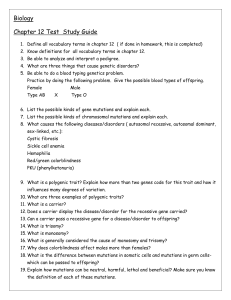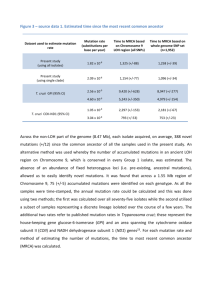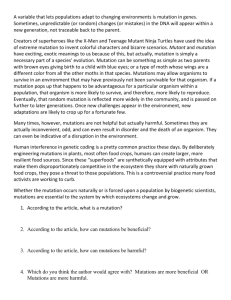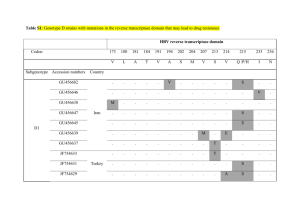25.5 Gene Mutations Gene Mutation Permanent change in
advertisement
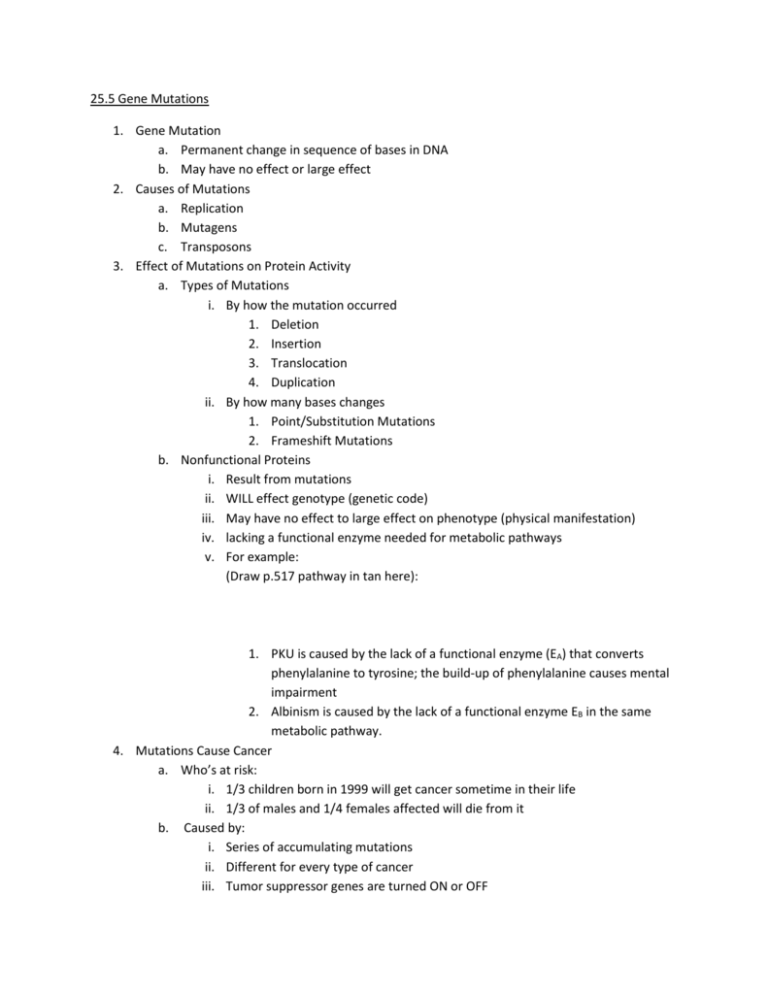
25.5 Gene Mutations 1. Gene Mutation a. Permanent change in sequence of bases in DNA b. May have no effect or large effect 2. Causes of Mutations a. Replication b. Mutagens c. Transposons 3. Effect of Mutations on Protein Activity a. Types of Mutations i. By how the mutation occurred 1. Deletion 2. Insertion 3. Translocation 4. Duplication ii. By how many bases changes 1. Point/Substitution Mutations 2. Frameshift Mutations b. Nonfunctional Proteins i. Result from mutations ii. WILL effect genotype (genetic code) iii. May have no effect to large effect on phenotype (physical manifestation) iv. lacking a functional enzyme needed for metabolic pathways v. For example: (Draw p.517 pathway in tan here): 1. PKU is caused by the lack of a functional enzyme (EA) that converts phenylalanine to tyrosine; the build-up of phenylalanine causes mental impairment 2. Albinism is caused by the lack of a functional enzyme EB in the same metabolic pathway. 4. Mutations Cause Cancer a. Who’s at risk: i. 1/3 children born in 1999 will get cancer sometime in their life ii. 1/3 of males and 1/4 females affected will die from it b. Caused by: i. Series of accumulating mutations ii. Different for every type of cancer iii. Tumor suppressor genes are turned ON or OFF iv. Proto-oncogenes mutate into oncogenes (Proto-oncogenes usually turned off in fully differentiated tissue) v. Carcinogenesis (cancer development) begins with loss of tumor suppressor gene activity and/or gain of oncogene activity (onco- as a prefix is used for cancer; e.g. oncologists are doctors who specialize in cancer treatment) c. Characteristics of Cancer Cells i. Genetically unstable ii. Do not correctly regulate the cell cycle (uncontrolled cell division) iii. Escape signals for death (telomeres do not shorted as they should) iv. Cancer cells can survive and proliferate (multiply) elsewhere in the body d. Types of Tumors i. Benign (local) ii. Metastatic (cancer is said to have “metastasized” and has the ability to spread to other parts of the body) e. Protective Behaviours i. List 3 protective behaviours (from p.519) that you currently practice: 1. 2. 3. ii. List 2 protective behaviours that you would like to practice: 1. 2. Answer p. 520 # 1-3 AND 1. Explain the difference between point and frameshift mutations. 2. Why might a mutation (point or frameshift) have either no effect or a large effect on the protein synthesized. Give an example. (You may wish to use p.516 example, or better yet, make up your own) 3. What is a mutagen? Give an example. 4. What are transposons? Give an example. 5. Why are errors in replication a rare cause of a mutation? 6. Explain how some mutations can be “silent”, i.e. have no effect on the protein synthesized? End of Chapter Review Read p.512-522 “Summarizing the Concepts” Complete p.522-523 “Testing Yourself” Read p..523 “Understanding the Terms” and look up the definitions for any terns that you are not familiar with. Complete p.523 “Thinking Critically”




